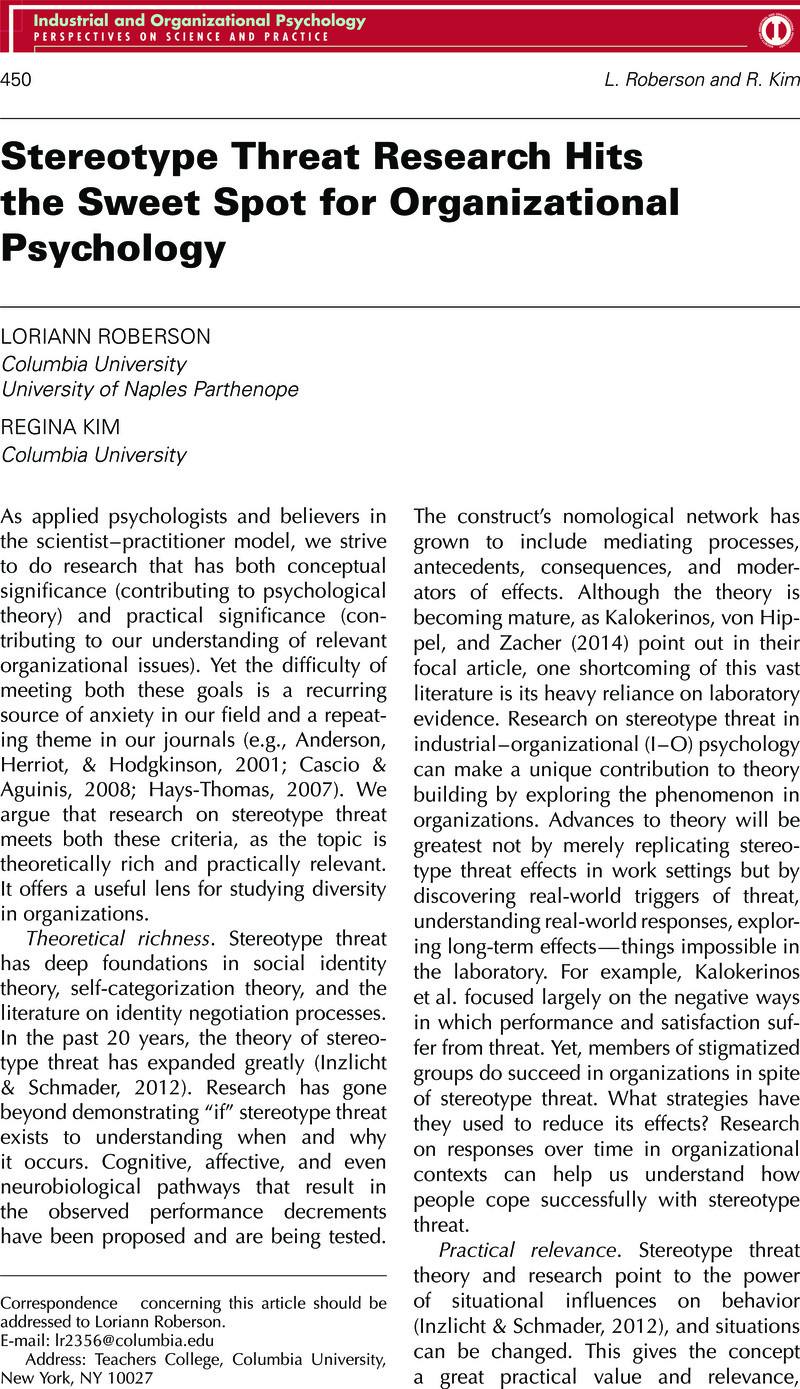No CrossRef data available.
Article contents
Stereotype Threat Research Hits the Sweet Spot for Organizational Psychology
Published online by Cambridge University Press: 07 January 2015
Abstract
An abstract is not available for this content so a preview has been provided. Please use the Get access link above for information on how to access this content.

- Type
- Commentaries
- Information
- Copyright
- Copyright © Society for Industrial and Organizational Psychology 2014
References
Anderson, N., Herriot, P., & Hodgkinson, G. P. (2001). The practitioner–researcher divide in industrial, work and organizational (IWO) psychology: Where are we now, and where do we go from here? Journal of Occupational and Organizational Psychology, 74, 391–411.CrossRefGoogle Scholar
Cascio, W. F., & Aguinis, H. (2008). Research in industrial and organizational psychology from 1963–2007: Changes, choices, and trends. Journal of Applied Psychology, 93, 1062–1081.Google Scholar
Chugh, D., & Brief, A. P. (2008). Introduction: Where the sweet spot is: Studying diversity in organizations. In Brief, A. P. (Ed.), Diversity at work (pp. 1–10). New York, NY: Cambridge University Press.Google Scholar
Ferdman, B. M. (2013). Toward enhancing industrial and organizational psychology's contributions to diversity and inclusion practice. Industrial and Organizational Psychology: Perspectives on Science and Practice, 6(3), 237–241.Google Scholar
Gluszek, A., & Dovidio, J. F. (2010). The way they speak: Stigma of non-native accents in communication. Personality and Social Psychology Review, 14, 214–237.Google Scholar
Hays-Thomas, R. (2007). On the difficulty of practicing what (science) we preach. The Psychologist-Manager Journal, 10, 173–176.CrossRefGoogle Scholar
Hays-Thomas, R., & Bendick, M. Jr. (2013). Professionalizing diversity and inclusion practice: Should voluntary standards be the chicken or the egg? Industrial and Organizational Psychology: Perspectives on Science and Practice, 6(3), 193–205.Google Scholar
Huang, L., Frideger, M., & Pearce, J. L. (2013). Political skill: Explaining the effects of nonnative accent on managerial hiring and entrepreneurial investment decisions. Journal of Applied Psychology, 98, 1005–1017.CrossRefGoogle ScholarPubMed
Inzlicht, M., & Schmader, T. (2012). Introduction. In Inzlicht, M., & Schmader, T. (Eds.), Stereotype threat: Theory, process, and application (pp. 3–14). New York, NY: Oxford University Press.Google Scholar
Kalokerinos, E. K., von Hippel, C., & Zacher, H. (2014). Is stereotype threat a useful construct for organizational psychology research and practice? Industrial and Organizational Psychology: Perspectives on Science and Practice, 7(3), 381–402.Google Scholar
Neeley, T. B. (2013). Language matters: Status loss and achieved status distinctions in global organizations. Organization Science, 24, 476-497.Google Scholar
Rucci, A. J. (2008). I-O psychology's “core purpose”: Where science and practice meet. The Industrial Organizational Psychologist, 46, 17–24.Google Scholar
Shore, L. M., Randel, A. E., Chung, B. G., Dean, M. M., Ehrhardt, K. H., & Singh, G. (2011). Inclusion and diversity in work groups: A review and model for future research. Journal of Management, 37, 1262–1289.Google Scholar
Tenzer, H. (2013, August). Language, emotional climate and team performance: The moderating role of emotionally capable leaders. In L. Roberson & M. Russo (Chairs), Language and linguistic diversity in the workplace: Does the way we speak really matter? Symposium conducted at the annual meeting of the Academy of Management, Orlando, FL.Google Scholar
Walton, G. M., & Carr, P. B. (2012). Social belonging and the motivation and intellectual achievement of negatively stereotyped students. In Inzlicht, M., & Schmader, T. (Eds.), Stereotype threat: Theory, process, and application (pp. 107–123). New York, NY: Oxford University Press.Google Scholar




